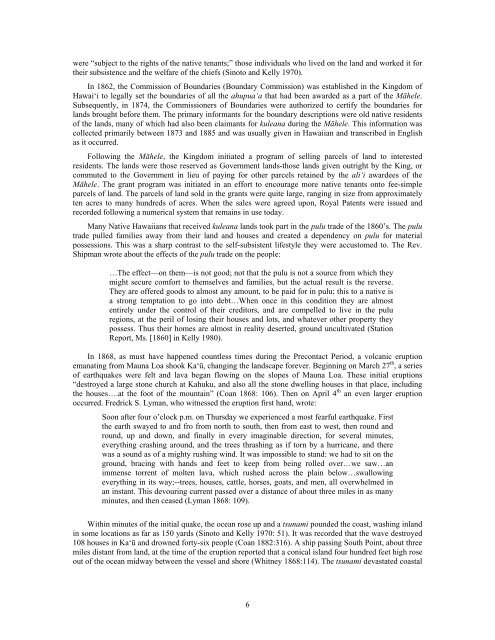Honu'apo Park Resource Management Plan
Honu'apo Park Resource Management Plan
Honu'apo Park Resource Management Plan
You also want an ePaper? Increase the reach of your titles
YUMPU automatically turns print PDFs into web optimized ePapers that Google loves.
were “subject to the rights of the native tenants;” those individuals who lived on the land and worked it for<br />
their subsistence and the welfare of the chiefs (Sinoto and Kelly 1970).<br />
In 1862, the Commission of Boundaries (Boundary Commission) was established in the Kingdom of<br />
Hawai‘i to legally set the boundaries of all the ahupua‘a that had been awarded as a part of the Māhele.<br />
Subsequently, in 1874, the Commissioners of Boundaries were authorized to certify the boundaries for<br />
lands brought before them. The primary informants for the boundary descriptions were old native residents<br />
of the lands, many of which had also been claimants for kuleana during the Māhele. This information was<br />
collected primarily between 1873 and 1885 and was usually given in Hawaiian and transcribed in English<br />
as it occurred.<br />
Following the Māhele, the Kingdom initiated a program of selling parcels of land to interested<br />
residents. The lands were those reserved as Government lands-those lands given outright by the King, or<br />
commuted to the Government in lieu of paying for other parcels retained by the ali‘i awardees of the<br />
Māhele. The grant program was initiated in an effort to encourage more native tenants onto fee-simple<br />
parcels of land. The parcels of land sold in the grants were quite large, ranging in size from approximately<br />
ten acres to many hundreds of acres. When the sales were agreed upon, Royal Patents were issued and<br />
recorded following a numerical system that remains in use today.<br />
Many Native Hawaiians that received kuleana lands took part in the pulu trade of the 1860’s. The pulu<br />
trade pulled families away from their land and houses and created a dependency on pulu for material<br />
possessions. This was a sharp contrast to the self-subsistent lifestyle they were accustomed to. The Rev.<br />
Shipman wrote about the effects of the pulu trade on the people:<br />
…The effect—on them—is not good; not that the pulu is not a source from which they<br />
might secure comfort to themselves and families, but the actual result is the reverse.<br />
They are offered goods to almost any amount, to be paid for in pulu; this to a native is<br />
a strong temptation to go into debt…When once in this condition they are almost<br />
entirely under the control of their creditors, and are compelled to live in the pulu<br />
regions, at the peril of losing their houses and lots, and whatever other property they<br />
possess. Thus their homes are almost in reality deserted, ground uncultivated (Station<br />
Report, Ms. [1860] in Kelly 1980).<br />
In 1868, as must have happened countless times during the Precontact Period, a volcanic eruption<br />
emanating from Mauna Loa shook Ka‘ū, changing the landscape forever. Beginning on March 27 th , a series<br />
of earthquakes were felt and lava began flowing on the slopes of Mauna Loa. These initial eruptions<br />
“destroyed a large stone church at Kahuku, and also all the stone dwelling houses in that place, including<br />
the houses….at the foot of the mountain” (Coan 1868: 106). Then on April 4 th an even larger eruption<br />
occurred. Fredrick S. Lyman, who witnessed the eruption first hand, wrote:<br />
Soon after four o’clock p.m. on Thursday we experienced a most fearful earthquake. First<br />
the earth swayed to and fro from north to south, then from east to west, then round and<br />
round, up and down, and finally in every imaginable direction, for several minutes,<br />
everything crashing around, and the trees thrashing as if torn by a hurricane, and there<br />
was a sound as of a mighty rushing wind. It was impossible to stand: we had to sit on the<br />
ground, bracing with hands and feet to keep from being rolled over…we saw…an<br />
immense torrent of molten lava, which rushed across the plain below…swallowing<br />
everything in its way;--trees, houses, cattle, horses, goats, and men, all overwhelmed in<br />
an instant. This devouring current passed over a distance of about three miles in as many<br />
minutes, and then ceased (Lyman 1868: 109).<br />
Within minutes of the initial quake, the ocean rose up and a tsunami pounded the coast, washing inland<br />
in some locations as far as 150 yards (Sinoto and Kelly 1970: 51). It was recorded that the wave destroyed<br />
108 houses in Ka‘ū and drowned forty-six people (Coan 1882:316). A ship passing South Point, about three<br />
miles distant from land, at the time of the eruption reported that a conical island four hundred feet high rose<br />
out of the ocean midway between the vessel and shore (Whitney 1868:114). The tsunami devastated coastal<br />
6


